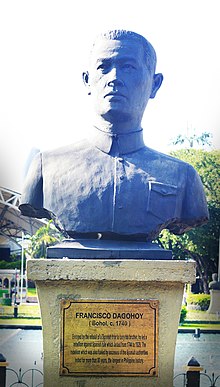| Dagohoy rebellion | |||||||
|---|---|---|---|---|---|---|---|
| Part of the Philippine revolts against Spain | |||||||
| |||||||
| Belligerents | |||||||
|
| Boholano people | ||||||
| Commanders and leaders | |||||||
|
|
Francisco Dagohoy Ignacio Arañez Pedro Baguio Bernardo Sanote Maximino Dagohoy (Sendrijas) | ||||||
| Strength | |||||||
| 2,200 soldiers | 3,000–20,000 followers (in 1744) | ||||||
| Casualties and losses | |||||||
| 546 killed (mainly ambushed) |
19,420 surrendered 395 died in battle 98 exiled | ||||||

The Dagohoy rebellion, also known as the Dagohoy revolution and the Dagohoy revolt, is considered as the longest rebellion in Philippine history. Led by Francisco Dagohoy, or Francisco Sendrijas, the rebellion took place on the island of Bohol from 1744 to 1800, lasting for roughly 56 years.
It was one of two significant revolts that occurred in Bohol during the Spanish era. The other one was the Tamblot uprising in 1621 led by Tamblot, a babaylan or native priest from Bohol which was basically a religious conflict.
Legacy

The Dagohoy rebellion features in the Bohol provincial flag as one of the two Sundang or native swords with handle and hand-guards on top. These two sundang, which are reclining respectively towards the left and right, depict the Dagohoy and Tamblot revolts, symbolizing that "a true Boholano will rise and fight if supervening factors embroil them into something beyond reason or tolerance."
The town of Dagohoy, Bohol is named in his honor. It was Vice President Carlos P. Garcia who proposed the name "Dagohoy" in honor of Francisco Sendrijas alias Dagohoy. The name Dagohoy is a concatenation of the Visayan phrase Dagon sa huyuhoy or "talisman of the breeze" in English.
The Dagohoy Memorial National High School in Dagohoy, Bohol is also named in his honor and memory.
References
- "Colorful History of Danao Bohol". Bohol-Philippines.com. December 1, 2013. Retrieved March 8, 2020.
- Readings From Bohol's History www.aenet.org, Source: Philippine Political and Cultural History. Volume I. Gregorio F. Zaide Retrieved 15 November 2006.
- Tirol, Jes.Abatan River Cruise: A travel through history Archived September 28, 2007, at archive.today www.boholchronicle.com Retrieved 21 November 2006.
- Bohol Flag and Seal Archived 2007-04-08 at the Wayback Machine Provincial Government of Bohol Retrieved 21 December 2006.
- Establishment of the town of Dagohoy, Bohol Archived 2006-09-27 at the Wayback Machine www.boholchronicle.com Retrieved 8 July 2006.
- Dagohoy Revolution
- Tirol, Jes End of Dagohoy Revolution Part 1
- Tirol, Jes. End of Dagohoy Revolution Part 2
Related Literature
- Agoncillo, Teodoro A. History of the Filipino People. GAROTECH Publishing, 1990 (8th Edition).
- Arcila, Jose S. Rizal and the Emergence of the Philippine Nation. 2001 revised edition.
- Constantino, Renato. The Philippines: A Past Revisited. Tala Publishing Series, 1975.
- Corpuz, Onofre D. The Roots of the Filipino Nation. 1989.
- Scott, William Henry. Barangay: Sixteenth-Century Philippine Culture and Society. AdMU: 1994.
- Zaide, Gregorio F. Great Filipinos in History: An Epic of Filipino Greatness in War and Peace. Verde Bookstore, 1970.
- Zaide, Gregorio. Dagohoy: Champion of Philippine Freedom. Manila: Enriquez, Alduan and Co., 1941.
External links
- Pugay, Chris Antonette P.The Revolts before the Revolution www.nhi.gov.ph
- 18th-century rebellions
- 19th-century rebellions
- History of Bohol
- Visayan history
- History of the Philippines (1565–1898)
- Philippine revolts against Spain
- 18th century in the Philippines
- 19th century in the Philippines
- 18th-century crimes in Asia
- 19th-century crimes in the Philippines
- 1829 in the Philippines
- 1744 in the Philippines